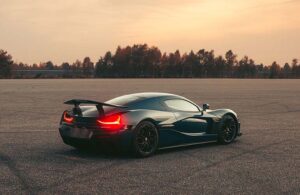Automobile giant, Rimac Automobili has broken records in manufacturing world’s fastest production electric car, Rimac Nevera with a top speed of 412kph (258mph).
 The record-breaking feat follows on from the Nevera’s independently verified 8.582-second quarter-mile run in 2021, which made it the world’s fastest accelerating production car.
The record-breaking feat follows on from the Nevera’s independently verified 8.582-second quarter-mile run in 2021, which made it the world’s fastest accelerating production car.
The Rimac team looked specifically for an oval with straights long enough to achieve the Nevera’s top speed, eventually settling on the Automotive Testing Papenburg track in Germany, with two 4km straights.
The Nevera was set into its top speed mode, creating an aerodynamic profile that balances drag and downforce to ensure stability at high speed.
Fitted with road-legal Michelin Cup 2R tires, and with the oversight of a Michelin technician to check their condition, the record-setting run got underway.
Behind the wheel was Miro Zrnčević, Rimac’s Chief Test and Development Driver. It was his challenge to get the perfect entry onto the straight from the track’s curved sections to give the car the best possible chance of reaching V-MAX.
As the car leveled out of the banking, travelling around 250kph (155mph), Miro unleashed the full power of the advanced four-motor Rimac-developed powertrain and battery pack, catapulting Nevera well into the 400kph range.
The top speed was measured using Racelogic V-Box, a high-precision GPS-based measurement device. The 412kph top speed was a target set by the Rimac team when the car was first unveiled as the C_Two at the Geneva Motor Show in 2018, and only now – after a collective 1.6m hours of development – was it verified.
Miro Zrnčević, Rimac’s Chief Test and Development Driver said “To travel at 412kph, or 258mph, means travelling at a third of the speed of sound. Simply achieving that alone in a road car is incredibly complex, but in Nevera we have created a car that can travel long distances on a single charge, can tackle tight and twisting race tracks and can drift as well as break straight-line speed records, both for acceleration and V-MAX. I’ve driven Nevera since it first turned a wheel and to see the perfectly honed car that is today is a emotional moment. The most important thing I have learned during the top-speed attempt is how composed and stable the car was – confirming that our aerodynamics and vehicle dynamics teams have done an amazing job.”
The Nevera is delivered to customers with a limited top speed of 219mph (352kph) but can achieve the 412kph (258mph) top speed in special customer events with support from the Rimac team and under controlled conditions. As tires are under a huge amount of stress during such runs, most of the precautions are directed toward making sure that the tires are properly set up for such high speeds. \
Production of the Nevera is currently underway at Rimac’s HQ on the outskirts of Zagreb, Croatia, and the first cars are already with customers around the world.
The Rimac Nevera produces 1,914hp from four Rimac-designed electric motors, which propel the hypercar from 0-60 mph in just 1.85 seconds, and to 100mph in 4.3 seconds.
